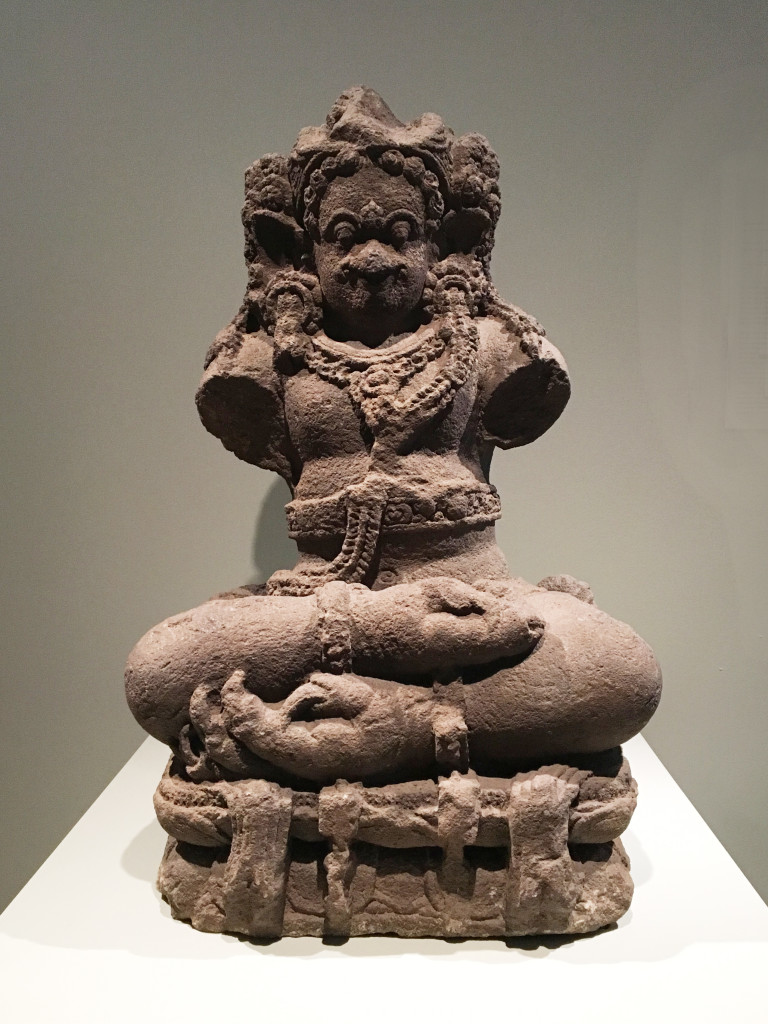Garuda Wall Text
Diaspora of Javanese Statues

Unknown
Indonesian (active Central Java)
Garuda, the Man-Bird as a Guardian King, 9th c. CE to 10th
Andesite (volcanic rock)
31 × 161/2 × 181/2 in.
SBMA, Museum purchase with funds provided by an Anonymous Donor
2013.18

Drawing of the textile pattern
COMMENTS
The massive stone statue of Garuda on view in the Santa Barbara Museum of Art is one of a kind and very unusual. It represents Garuda, the man-bird, as a guardian king. The Garuda remains the state symbol of Indonesia. He is seated cross-legged on a square lotus throne. The sashes from around his waist lie over the cushion, which is a typical Central Javanese feature. He wears the crown of a ruler, but he has flaring hair, which is a characteristic of a guardian figure. His eyes protrude on stalks in a somewhat demonic fashion. He is adorned with the ornaments of a king, with an exaggerated "upavita" as a thick heavy chain around the torso. Around his hips, tied at each side of the body, is evidence of the bow of the sash lying beneath the chain girdle around the waist. The sash is draped over the long "kain", which finishes at the ankles with heavy anklets. The pattern on the "kain" represents a simple four~petal flower in a circle, the carving of which, on account of the roughness of the volcanic stone, is not particularly well executed. The feet placed on the cushion, with the soles together in "sitasanamudra", is a feature that is apparent with these Ganesa from Central Java (often with the feet not quite touching).
- Lesley S Pullen, "Paterned Splendor: Textiles Presented on Javanese Metal and Stone Sculptures, Eighth to the Fifteenth Century", ISEAS - Yusof Ishak Institute, Singapore, 2021, p.70
SBMA CURATORIAL LABELS
Garuda is the mythical Lord of Birds in both Hindu and Buddhist traditions. He is primarily known as the solar vehicle for the Hindu god Vishnu, preserver of the universe, whom Garuda transports with great speed to resolve calamities in the world. Originally placed in or outside a shrine, this magnificent sculpture attests to a period in Central Java that witnessed the flourishing of hundreds of Buddhist and Hindu temples with ambitious sculptural programs, including the temple complexes at Borobudur and Loro Jonggrang.
Garuda’s missing arms may have once held a serpent (naga), the staple of his diet. His finely chiseled features and the curving lines of his robust body convey a ferocious yet meditative presence.
- India, Southeast Asia, and Himalayas, 2022
Garuda is the mythical Lord of Birds in both Hindu and Buddhist traditions. He is primarily known as the solar vehicle for the Hindu god Vishnu, preserver of the universe, whom Garuda transports with great speed to resolve calamities in the world. This superb sculpture with bulbous eyes, an eagle’s beak and large claws is a rare depiction of Garuda as a powerful demon-king and guardian (rakshasa).
Richly adorned he sits cross-legged on a lotus plinth. His wings and tail feathers fan out across his back. His missing arms may have once held a serpent (naga)—the staple of his diet. His finely chiseled features and the curving lines of his robust body, reflecting Indian artistic conventions, convey a ferocious yet meditative and noble presence.
- Ridley-Tree Gallery, 2016
